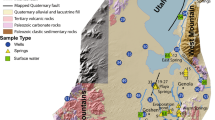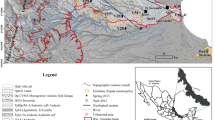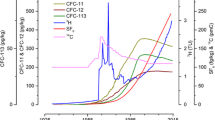Abstract
Groundwater chemistry and tracer-based age data were used to assess contaminant movement and geochemical processes in the middle Claiborne aquifer (MCA) of the Mississippi embayment aquifer system. Water samples were collected from 30 drinking-water wells (mostly domestic and public supply) and analyzed for nutrients, major ions, pesticides, volatile organic compounds (VOCs), and transient age tracers (chlorofluorocarbons, tritium and helium-3, and sulfur hexafluoride). Redox conditions are highly variable throughout the MCA. However, mostly oxic groundwater with low dissolved solids is more vulnerable to nitrate contamination in the outcrop areas east of the Mississippi River in Mississippi and west Tennessee than in mostly anoxic groundwater in downgradient areas in western parts of the study area. Groundwater in the outcrop area was relatively young (apparent age of less than 40 years) with significantly (p < 0.05) higher dissolved oxygen and nitrate–N concentrations and higher detections of pesticides and VOCs compared to water samples from wells in downgradient areas. Oxygen reduction and denitrification rates were low compared to other aquifers in the United States (zero order rate constants for oxygen reduction and denitrification were 4.7 and 5–10 μmol/L/year, respectively). Elevated concentrations of nitrate–N, and detections of pesticides and VOCs in some deep public supply wells (>50 m depth) indicated contaminant movement from shallow parts of the aquifer into deeper oxic zones. Given the persistence of nitrate in young oxic groundwater that was recharged several decades ago, and the lack of a confining unit, the downward movement of young contaminated water may result in higher nitrate concentrations over time in deeper parts of the aquifer containing older oxic water.







Similar content being viewed by others
References
Burow KR, Nolan BT, Rupert MG, Dubrovsky NM (2010) Nitrate in groundwater of the United States, 1991–2003. Environ Sci Technol 44:4988–4997
Busenberg E, Plummer LN (1992) Use of chlorofluoromethanes (CCl3F and CCl2F2) as hydrologic tracers and age-dating tools: example- the alluvium and terrace system of central Oklahoma. Water Resour Res 28:2257–2283
Busenberg E, Plummer LN (2000) Dating young ground water with sulfur hexafluoride—natural and anthropogenic sources of SF6. Water Resour Res 36:3011–3030
Busenberg E, Weeks E, Plummer LN, Bartholemay RC (1993) Age dating groundwater by use of chlorofluorocarbons (CCl3F and CCl2F2), and distribution of chlorofluorocarbons in the unsaturated zone, Snake River Plain aquifer, Idaho National Engineering Laboratory, Idaho: USGS Water-Resources Investigations Report 93-4054. Reston, Virginia: USGS
Chapelle FH, Bradley PM, Thomas MA, McMahon PB (2009) Distinguishing iron-reducing from sulfate-reducing conditions in ground-water systems. Ground Water 46(2):300–305
Connor BF, Rose DL, Noriega MC, Murtagh LK, Abney SR (1998) Methods of analysis by the U.S. Geological Survey National Water Quality Laboratory—determination of 86 volatile organic compounds in water by gas chromatography/mass spectrometry, including detections less than reporting limits. U.S. Geological Survey Open-File Report 97–829, p 78
Coupe RH (2000) Occurrence of pesticides in five rivers of the Mississippi embayment study unit, 1996–98. U.S. Geological Survey Water-Resources Investigations Report 99-4159, p 55
Criner JH, Parks WS (1976) Historic water-level changes and pumpage from the principal aquifers of the Memphis area, Tennessee: U.S. Geological Survey Water-Resources Investigations Report 76-67, p 45
DeSimone LA (2009) Quality of water from domestic wells in principal aquifers of the United States, 1991–2004. U.S. Geological Survey Scientific Investigations Report 2008-5227, p 139
Dubrovsky NM, Burow KR, Clark GM et al (2010) The quality of our Nation’s waters—nutrients in the Nation’s streams and groundwater, 1992–2004: U.S. Geological Survey Circular 1350, p 174
Fishman MJ, Friedman LC (eds) (1989) Methods for determination of inorganic substances in water and fluvial sediments. U.S. Geological Survey Techniques of Water-Resources Investigations, Book 5, Chapter A1, p 545
Furlong ET, Anderson BD, Werner SL, Soliven PP, Coffey LJ, Burkhardt MR (2001) Methods of analysis by the U.S. Geological Survey National Water Quality Laboratory—determination of pesticides in water by graphitized carbon-based solid-phase extraction and high-performance liquid chromatography/mass spectrometry. U.S. Geological Survey Water-Resources Investigations Report 01-4134, p 73
Gilliom RJ, Barbash JE, Crawford CG et al (2006) The quality of our nation’s waters—Pesticides in the nation’s streams and ground water, 1992–2001: U.S. Geological Survey Circular 1291, p 172
Graham DD, Parks WS (1986) Potential for leakage among principal aquifers in the Memphis area, Tennessee: U.S. Geological Survey Water-Resources Investigations Report 85-4295, p 46
Green CT, Puckett LJ, Böhlke JK et al (2008) Limited occurrence of denitrification in four shallow aquifers in agricultural areas of the United States. J Environ Quality 37:994–1009
Green CT, Böhlke JK, Bekins BA, Phillips SP (2010) Mixing effects on apparent reaction rates and isotope fractionation during denitrification in a heterogeneous aquifer. Water Resour Res 46:W08525. doi:10.1029WR0088903
Heaton THE, Vogel JC (1981) Excess air in groundwater. J Hydrol 50:201–216
Homer CG, Huang CC, Yang L, Wylie B, Coan M (2004) Development of a 2001 National Landcover Database for the United States. Photogramm Eng Remote Sens 70(7):829–840
Hosman RL, Weiss JS (1991) Geohydrologic units of the Mississippi embayment and Texas coastal uplands aquifer systems, South-Central United States: U.S. Geological Survey Professional Paper 1416-B, p 19
Hosterman JW (1984) Ball clay and bentonite deposits of the central and western Gulf of Mexico Coastal Plain, United States. U.S. Geological Survey Bulletin 1558-C, p 22
Kenny JF, Barber NL, Hutson SS, Linsey KS, Lovelace JK, Maupin MA (2009) Estimated use of water in the United States in 2005. U.S. Geological Survey Circular 1344, p 52
Kingsbury JA (1996) Altitude of the potentiometric surfaces, September 1995, and historical water-level changes in the Memphis and Fort Pillow aquifers in the Memphis area, Tennessee: U.S. Geological Survey Water-Resources Investigations Report 96-4278, 1 sheet
Koterba MT (1998) Ground-water data-collection protocols and procedures for the National Water-Quality Assessment Program—Collection, documentation, and compilation of required site, well, subsurface, and landscape data for wells: U.S. Geological Survey Water-Resources Investigations Report 98–4107, p 91
LaBolle EM, Fogg GE, Eweis JB (2006) Diffusive fractionation of 3H and 3He in groundwater and its impact on groundwater age estimates. Water Resour Res 42(7):W07202
Landon MK, Clark BR, McMahon PB, McGuire VL, Turco MJ (2008) Hydrogeology, chemical-characteristics, and transport processes in the zone of contribution of a public-supply well in York, Nebraska. U.S. Geological Survey Scientific Investigations Report 2008-5050, p 149
Lapham WW, Wilde FD, Koterba MT (1995) Ground-water data-collection protocols and procedures for the National Water-Quality Assessment Program—selection, installation, and documentation of wells, and collection of related data: U.S. Geological Survey Open-File Report 95-398, p 69
Larsen D, Gentry RW, Solomon DK (2003) The geochemistry and mixing of leakage in a semi-confined aquifer at a municipal well field, Memphis, Tennessee, USA. Appl Geochem 18:1043–1063
Lloyd OB Jr, Lyke WL (1995) Ground water atlas of the United States: segment 10, Illinois, Indiana, Kentucky, Ohio, Tennessee: U.S. Geological Survey Hydrologic Investigations Atlas 730-K, p 30
Ludin A, Weppernig R, Bonisch G, Schlosser P (1998) Mass spectrometric measurement of helium isotopes and tritium: Palisades, New York, Lamont-Doherty Earth Observatory, Technical Report 98-06
Lumsden DN, Hundt KR, Larsen D (2009) Petrology of the Memphis sand in northern Mississippi embayment. Southeast Geol 46(3):121–133
Maupin MA, Barber NL (2005) Estimated withdrawals from principal aquifers in the United States, 2000: U.S. Geological Survey Circular 1279, p 46
McMahon PB, Chapelle FH (2008) Redox processes and water quality of selected principal aquifers. Ground Water 46(2):259–271
Michel RM (1989) Tritium deposition in the continental United States 1953–1983. U.S. Geological Survey Water Resources Investigations Report 89–4072, 46 p
Natural Resources Conservation Service, United States Department of Agriculture (2007) Soil Survey Geographic (SSURGO) Database for Mississippi and Tennessee. http://soildatamart.nrcs.usda.gov accessed 2007 at http://soildatamart.nrcs.usda.gov
Newcome R Jr (1976) The Sparta aquifer system in Mississippi: U.S. Geological Survey Water-Resources Investigations 76-7, 3 plates
Nolan BT, Hitt KJ (2006) Vulnerability of shallow groundwater and drinking-water wells to nitrate in the United States. Environ Sci Technol 40:7834–7840
O’Dell JW (1993) Method 180.1 Determination of turbidity by nephelometry. Environmental Monitoring Systems Laboratory Office of Research and Development, U.S. Environmental Protection Agency, Cincinnati, OH, p 8
Parks WS (1990) Hydrogeology and preliminary assessment of the potential for contamination of the Memphis aquifer in the Memphis area, Tennessee: U.S. Geological Survey Water-Resources Investigations Report 90-4092, p 39
Parks WS, Mirecki JE, Kingsbury JA (1995) Hydrogeology, ground-water quality, and source of ground water causing water-quality changes in the Davis well field at Memphis, Tennessee. U.S. Geological Survey Water-Resources Investigations Report 94-4212, p 58
Plummer LN, Busenberg E (2000) Chlorofluorocarbons. In: Cook PG, Herczeg A (eds) Environmental tracers in subsurface hydrology. Kluwer Academic Press, Boston, pp 441–478
Plummer LN, Michel RL, Thurman EM, Glynn PD (1993) Environmental tracers for age-dating young groundwater. In: Alley WA (ed) Regional groundwater quality. Van Nostrand Reinhold, New York, pp 255–294
Plummer LN, Prestemon EC, Parkhurst D (1994) An Interactive Code (NETPATH) for Modeling Net Geochemical Reactions Along a Flow Path: Version 2.0. U.S. Geological Survey Water-Resources Investigations Report 94-4169, Reston, VA, p 130
Puckett LJ, Tesoriero AJ, Dubrovsky NM (2011) Nitrogen contamination of surficial aquifers—a growing legacy. Environ Sci Technol 45(3):839–844
Reilly TE, Plummer LN, Phillips PJ, Busenberg E (1994) The use of simulation and multiple environmental tracers to quantify groundwater flow in a shallow aquifer. Water Resour Res 30:421–433
Renken RA (1998) Ground water atlas of the United States: Segment 5, Arkansas, Louisiana, Mississippi: U.S. Geological Survey Hydrologic Investigations Atlas 730-F, p 28
Ruddy BC, Lorenz DL, Mueller DK (2006) County-level estimates of nutrient inputs to the land surface of the conterminous United States, 1982–2001. U.S. Geological Survey Scientific Investigations Report 2006–5012. http://pubs.usgs.gov/sir/2006/5012. Accessed 28 February 2011
Schlosser P, Stute M, Dorr H, Sonntag C, Munnich KO (1988) Tritium/3He dating of shallow groundwater. Earth Planet Sci Lett 89:353–362
Schlosser P, Stute M, Sonntag C, Munnich KO (1989) Tritiogenic 3He in shallow ground water. Earth Planet Sci Lett 94:245–256
Schrader TP (2007) Potentiometric surface in the Sparta-Memphis aquifer of the Mississippi Embayment, spring 2007: U.S. Geological Survey Scientific Investigations Map 3014, 1 sheet
Scott JC (1990) Computerized stratified random site-selection approaches for design of a ground-water quality sampling network. U.S. Geological Survey Water-Resources Investigations Report 90-4101, p 109
Solomon DK, Sudicky EA (1991) Tritium and helium-3 isotope ratios for direct estimation of spatial variations in groundwater recharge. Water Resour Res 27:2309–2319
Spann EW (1998) Selected sediment and geochemical properties of quaternary and tertiary sediments from five boreholes in Shelby County, Tennessee: Implications for contaminant retardation potential. Unpublished MS Thesis. University of Memphis
Tesoriero AJ, Puckett LJ (2011) O2 reduction and denitrification rates in shallow aquifers. Water Resources Research. (in press)
Thatcher LL, Janzer VJ, Edwards KW (1977) Methods for determination of radioactive substances in water and fluvial sediments. USGS Techniques of Water Resources Investigations. Book 5, Chapter A5. U.S. Gov. Print. Office, Washington, DC
Torgersen T, Clarke WB, Jenkins WJ (1979) The tritium/helium-3 method in hydrology. In: Isotope hydrology 1978, IAEA, Vienna, pp 917–929
U.S. Census Bureau (2010) Census. 2010 Census Redistricting Data (Public Law 94-171) Summary File, Tables P1 and H1
Ward MH, deKok TM, Levallois P, Brender J, Gulis G, Nolan BT, VanDerslice J (2005) Workgroup report: drinking-water nitrate and health—recent findings and research needs. Environ Health Perspect 113(11):1607–1614
Webbers A (2003) Public-water supply systems and associated water use in Tennessee, 2000: Water-Resources Investigations Report 03-4264, p 90
Welch HL, Kingsbury JA, Tollett RW, Seanor RC (2009) Quality of shallow groundwater and drinking water in the Mississippi embayment-Texas coastal uplands aquifer system and the Mississippi River Valley alluvial aquifer, south-central United States, 1994–2004: U.S. Geological Survey Scientific Investigations Report 2009–5091, p 51
Welch HL, Green CT, Coupe RH (2011) The fate and transport of nitrate in shallow groundwater in northwestern Mississippi. Hydrogeol J. doi:10.1007/s10040-011-0748-8
Zaugg SD, Sandstrom MW, Smith SG, Fehlberg KM (1995) Methods of analysis by the U.S. Geological Survey National Water-Quality Laboratory—determination of pesticides in water by C-18 solid-phase extraction and capillary-column gas chromatography/mass spectrometry with selected-ion monitoring. U.S. Geological Survey Open-File Report 95-181, p 49
Zogorski JS, Carter JM, Ivahnenko T et al (2006) The quality of our Nation’s waters—volatile organic compounds in the Nation’s ground water and drinking-water supply wells: U.S. Geological Survey Circular 1292, p 101
Acknowledgments
This research study was funded by the US Geological Survey’s National Water Quality Assessment Program (NAWQA). Special thanks are extended to the homeowners and utilities for allowing us to collect water samples from their wells. The authors gratefully acknowledge R.C. Seanor for GIS support; and J.K. Carmichael, C.T. Green, S.C. Cooper, and several anonymous reviewers for their comments and suggestions that significantly improved earlier versions of this paper.
Author information
Authors and Affiliations
Corresponding author
Rights and permissions
About this article
Cite this article
Katz, B.G., Kingsbury, J.A., Welch, H.L. et al. Processes affecting geochemistry and contaminant movement in the middle Claiborne aquifer of the Mississippi embayment aquifer system. Environ Earth Sci 65, 1759–1780 (2012). https://doi.org/10.1007/s12665-011-1157-y
Received:
Accepted:
Published:
Issue Date:
DOI: https://doi.org/10.1007/s12665-011-1157-y




